We are delighted to announce for our site over the coming months a short, Theodore and Mabel Bent-related series of ‘incidentals’ covering the Cycladic island of Anáfi, presented by anthropologist and Anáfi expert Professor Margaret Kenna. Margaret is a retired social anthropologist from Swansea University who has been carrying out research on Anáfi, and among Anáfiot migrants in Athens, since 1966. She has written two books and many articles in English about her research: Greek Island Life: Fieldwork on Anafi (2nd edition 2017, Sean Kingston Publishing), and The Social Organisation of Exile: Greek Political Dissidents in the 1930s (2001, Routledge). A Greek translation of the second book was published in 2004 by Alexandreia Press. Many of her articles, in English and in Greek translation, can be found on the websites: academia.edu and ResearchGate. She has also written several booklets which can be found in tourist shops on the island: Anafi: a Brief Guide; Anafi: Island of Exile; The Folklore and Traditions of Anafi, and The Traditional Embroideries of Anafi. She was made an Honorary Citizen of the island in 2006.
We begin Professor Kenna’s thyme-scented series with ‘Adventures getting to, and leaving, Anafi: 1884 and 1983’, comparing Margaret’s own reminiscences on the island’s (in)accessibility with those of Theodore and Mabel, through a lens of 100 years. We very much hope you enjoy what follows and decide to look out for forthcoming Anáfi ‘talks’ soon on our site; by all means send in your comments to the Bent Archive!
ανάφηανάφηανάφηανάφη
Adventures getting to, and leaving, Anafi: 1884 and 1983
by Margaret Kenna
“In early January 1884, Theodore and Mabel Bent spent sixteen hours on a caïque travelling from Santorini to Anafi. They landed at around two o’clock in the morning, at a little inlet about two hours away from the village (Theodore describes it as on ‘the north side of the island’, but it is, more accurately, on the north-west coast, north of the fertile western area known as Vayia). This inlet, identified as Prassa, was until a few decades ago used whenever adverse winds and bad weather prevented vessels from getting to the main harbour of Ayios Nikolaos on the south coast of the island.
“Being opposite Santorini, and thus likely to have received stones, rocks and lava from its volcanic eruptions, the inlet has some very striking rock formations:
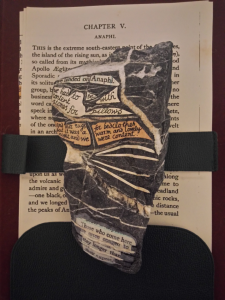 Pebble from Prassa, commemorating the Bents’ arrival there (art-work by Lito Apostolakou, inklinks.etsy.com)
Pebble from Prassa, commemorating the Bents’ arrival there (art-work by Lito Apostolakou, inklinks.etsy.com)
“While Mabel’s diary (courtesy of Gerry Brisch (Bent 2006: 33)) notes that, once landed, they scrambled over ‘thorns, stones, rocks, and streams’ for an hour before they found a chapel where they could take shelter and spend the rest of the night, Theodore omits all the scrambling and notes his appreciation of ‘those churches, which are dotted everywhere over the islands for benighted wayfarers like ourselves’ (Bent 1885: 44). After this very ethnocentric observation, he comments on the small size of the chapel and its mud floor on which they slept with stones for pillows and their travelling rugs as blankets (also noted by Mabel). No mention at all is made by Theodore of the ‘old man whose son-in-law had died on Anaphe’ who was on the caïque with them, according to Mabel, and had come over ‘to fetch his daughter’. This human interest story is omitted by Theodore, who simply tells us that in the morning they sent their ‘manservant’ (and guide and translator), identified by Gerry Brisch as Matthaios Simos (himself from Anafi), to the village to get mules. While waiting for him to return, they breakfasted on some bacon they had with them, cooked over a brushwood fire. They set off for the village, taking with them mail for the villagers, for which the island had been waiting for two months.
“Almost one hundred years after the Bents arrived at Prassa, when bad weather in April 1983 prevented the steamer from approaching Ayios Nikolaos, five of us, four adults and a four-year old child, had to cross the island on foot to Prassa. Our luggage was on donkeys, for in those days, as in the Bents’ time, there were no roads and no wheeled vehicles (although there was electricity in the village, and a few telephones). Having hurried along rocky paths and across country for several hours, we arrived at Prassa. There, while the steamer waited out at sea, we jumped from a flat rock, which served as a landing stage, into a dinghy, which rowed us out to the steamer, and then collected supplies and a mail bag. Luckily, not an adventure to be repeated as now there is a more-or-less wind-and-weather-withstanding jetty at Ayios Nikolaos harbour.
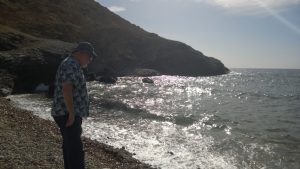 Prassa in May 2016: the ‘landing stage/embarkation’ platform is the large, sunlit, pale grey, rock sticking out from the cliff in the centre of the picture (photo: Margaret Kenna)
Prassa in May 2016: the ‘landing stage/embarkation’ platform is the large, sunlit, pale grey, rock sticking out from the cliff in the centre of the picture (photo: Margaret Kenna)
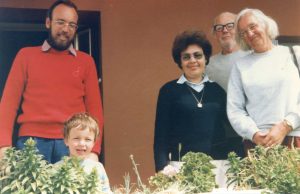 Spring 1983: on Anafi, some of the party, with local friend (in black) just before the cross-country trek to Prassa (photo: Margaret Kenna)
Spring 1983: on Anafi, some of the party, with local friend (in black) just before the cross-country trek to Prassa (photo: Margaret Kenna)
“The Bents had to cut short their stay as the weather was fine and the caïque was waiting, so they were only on the island for two days (9th to 11th January). They collected mail to take to Santorini, and Mabel reports that they were accompanied by the old man, his widowed daughter and her baby (so we do know a little bit more about that human interest story), and Matthaios Simos’s cousin, Margarita.”
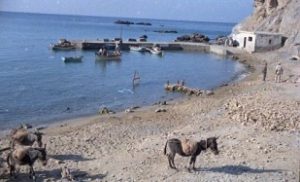 The harbour of Ayios Nikolaos in summer 1966. It is likely that only the very short jetty would have existed when the Bents left the island on 11 January 1884 (photo: Margaret Kenna)
The harbour of Ayios Nikolaos in summer 1966. It is likely that only the very short jetty would have existed when the Bents left the island on 11 January 1884 (photo: Margaret Kenna)
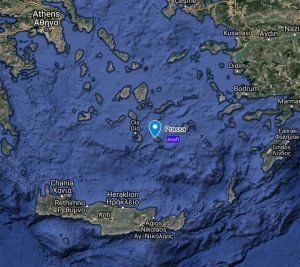 An isle in context. Map showing the tiny island of Anafi in the Cyclades. Prassa is on the north-west (map: Google)
An isle in context. Map showing the tiny island of Anafi in the Cyclades. Prassa is on the north-west (map: Google)
References
Bent, Mabel and Brisch, Gerald (ed.) 2006. The Travel Chronicles of Mrs. J. Theodore Bent, Vol I: Greece and the Levantine Littoral. Oxford, Archaeopress.
Bent, Theodore 1885 (2002). The Cyclades, or Life Among the Insular Greeks. Oxford, Archaeopress.

I visited Prassa in September 2017 while walking in the footsteps of Theodore and Mabel. Of course, I was keen to find the little church where they spent the night after their horrendous journey from Santorini and I wonder whether Margaret Kenna has identified the church.
From my visit, albeit by more modern means of transport, it could be a small chapel some distance up the stream course from the beach, a short diversion off the dirt road leading down to the beach. It’s the right size but I doubt that it would have taken the Bents an hour to get there, although darkness would have slowed their progress. The other possibility is the church of Aghios Panteleimon further up on the now-tarmac’d section of the road to Chora. It’s quite a big church now but it’s clear there is a smaller older structure at its heart from some stage of its past.
I favour the small chapel by the stream bed with a view to the beach, mostly because they would have had to pass by it, and, being desperate for shelter, would have welcomed such a fortuitous discovery and not pressed on further. Of course, it’s always difficult to date these churches so it would be interesting if Margaret could confirm, from her local contacts, whether it existed at the time of the Bents’ visit.
Margaret,
Your 1983 arrival, and visit, was a real adventure which I much admire. Anáfi is still not always easy of access and I’ve reproduced below an account I posted on Facebook just last year in September 2017.
“As we left Santorini behind us, the sun was already beginning its descent toward the mountain of Mesa Vouno. The wind picked up. Ninety minutes later, the sea-spray was reaching the passenger deck of the Aqua Jewel as she cleared the harbour mole of Anafi and made her first attempt at docking.
It seemed, I thought, that she was reversing more slowly than is usual, coming in at a strange angle for docking. The few passengers onboard made their way to the car deck. It seemed an age before the ramp went down and we could see the expectant crowd waiting on the dockside. A blonde girl with tattooed arms blew tattooed kisses to her waiting boyfriend. Others waved to friends in the dockside gathering. The ramp was within millimetres of kissing the familiar concrete. But, up it went, then down again, then up again, countless times as the captain determined the wind shear was too strong to safely plant the ramp on the dock. A priest crossed himself. The time seemed right. Hawsers, descending from above the open ramp door, were thrown ashore and hooked around stout capstans. But no! The vessel ‘crabbed’ again and urgent shouts instructed the dock crew to loose the hawsers as the ship’s powerful engines went into overdrive to avoid collision with the dock. The hawsers, dripping sea water, were winched back onboard as the deck crew pushed everyone back, away from the danger of the open door and the swinging hawsers. The ramp door closed tight, shutting out the last of the evening sunlight. The ship was secured for sea and its engines continued under power. Strangers became friends, united by a shared unease.
After ten minutes or so, I climbed the stairs back onto the upper deck to find the ship some good distance from the port. “Safer on deck”, I thought, “than down below on the car deck”. I spoke to the purser – “This ship not good in the wind” he said, with a shaking of his outstretched hand. Maria, a Greek girl from Athens, on holiday from her job as a lecturer at the University of Bedfordshire in the UK, came back to tell us that the Captain had hoped to attempt docking on the other side of the harbour mole but had aborted that too – we were going back round to try again at the original dock.
The second attempt was barely more successful. The ramp performed its now familiar choreography. When it was at one point half a metre from the concrete of the dock, love could wait no longer – the tattooed girl, with an Olympian sprint, ran up the incline of the ramp leaping onto Terra Firma and into the arms of her waiting boyfriend. Sensing freedom, a man followed her. A third, encumbered by the weight of his backpack, was too slow and ended up being bear-hugged by a crew member. For fear of ensuing rebellion, the crew pushed us remaining passengers back away from the ramp door. Finally, after an interminable wait, we disembarked, amid sighs of relief, after an hour and a half being tossed around at the mercy of the Aegean winds.
I’m here in Anafi for five days; it’s one of the least accessible of the Cyclades with epithets such as: the island the Gods forgot and the island of the Rising Sun. In the 1920s and 1930s it was a place of exile for political dissenters. I can understand why now, it’s not easy of access. Let’s hope the winds are more favourable for my ‘escape’ on Sunday.”